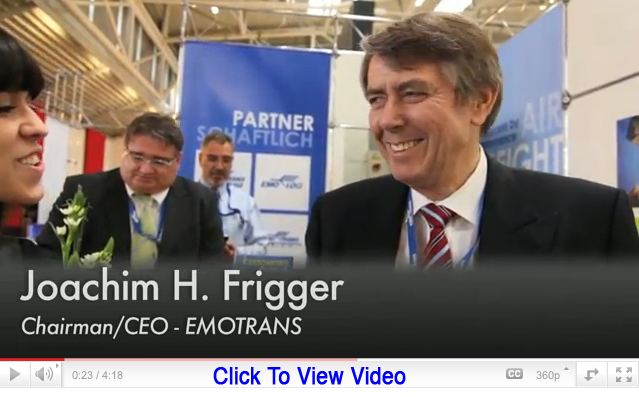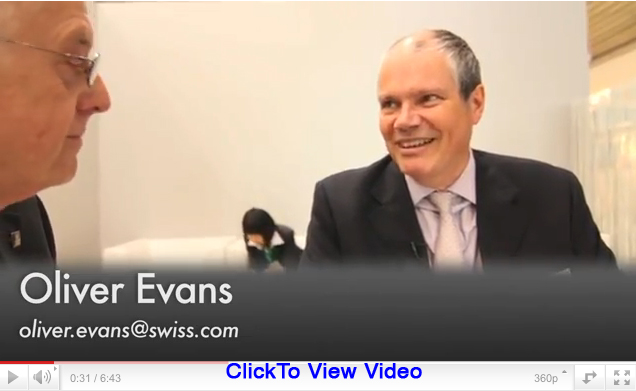
 We
sat down with Patrick Murray, Head of Calogi, one of the fastest growing,
air cargo solutions portals in the world, to find out what a look back
on 2011 informs Calogi about, when looking forward to 2012. We
sat down with Patrick Murray, Head of Calogi, one of the fastest growing,
air cargo solutions portals in the world, to find out what a look back
on 2011 informs Calogi about, when looking forward to 2012.
The key word here is ‘growth.’
“2011 has been a challenging and
exciting year for us. In anticipation of our expansion, we have grown
our team to over 100 people, which includes IT, business support, help
desk, e-commerce and sales and marketing.
“Meanwhile the number of users,
companies and transactions has grown by 20 percent versus the beginning
of the year. Not bad considering the downturn experienced in recent
times.
“I have always had the belief that
smart business people will continue to invest in cost-effective solutions
during times of hardship to give themselves the edge during and after
a slump,” said Mr. Murray.
“During the year we ran a successful
pilot in Dakar, Bangladesh, and are now live at that airport. We met
with industry leaders in several countries to gain their insights into
how we can successfully implement Calogi in their respective communities
and have addressed their feedback.
“We have also expanded our presence
at Dubai World Central-Al Maktoum International Airport (DWC), Sharjah
and Abu Dhabi.”
Calogi made certain to create a system
that is affordable across a spectrum of users, while also constantly
evolving to meet and address the needs of the cargo community.
“We continue to develop and offer
low cost, functionally rich solutions and took the decision to price
our solution so that it is well within the reach of the smallest stakeholder.
“Our software developments are based
on industry and stakeholder requirements. We continue to deliver many
of these features as part of the Calogi offering and at no extra charge
to benefit the industry.
“One such instance is the ability
to police the format of the shipper and consignee post code, by country,
to ensure that the electronic data is in an acceptable format to Customs
authorities.
“We have an excellent and unique
product which simplifies the air cargo supply chain, increases efficiency
and can both generate income and reduce costs.
“Our model here in Dubai stands
testament to that claim and I still invite industry leaders who are
serious about reducing their costs or growing their business to visit
us and speak to some of our customers,” said Mr. Murray.
We are not at all surprised by the confidence
assumed by Mr. Murray; after all, he has been knee-deep in IT matters
for some time now—just ask IATA, British Airways or Mercator.
But with all things pioneering, problems are certain to arise that were
never even assumed to have existed before; such is the nature of inventing
in a void. According to Mr. Murray, these issues can be easily addressed
through connectivity and cooperation.
“We have electronic messaging agreements
in place with 26 airlines and are currently running campaigns to sign
up more as the momentum to replace the paper air waybill document with
e-AWB grows.
“One of the major hurdles to implementing
e-AWB is the paper-based process, which relies on the airline issuing
pre-printed stock and the agent executing the same on a typewriter.
“Ideally there needs to be a push
from IATA to eradicate this outdated process. Meanwhile, we continue
to fully support the e-AWB and e-freight initiatives,” said Mr.
Murray.
“Another challenge is that much
of what we do is a first for the industry and is changing widely accepted
practices.
“For instance our unique ad-hoc
air waybill release feature has enabled each airline/GSA to do business
with over 400 forwarders in Dubai without the need for the traditional
stock release and associated payment delays and credit risks.
“The airline makes a pool of air
waybill stock available to the community and each forwarder has the
option to assign an air waybill, from that pool, to a particular job.
Upon execution of the air waybill, the monies are deducted from the
forwarders Calogi c-Trade (credit) account with a guaranteed payment
to the relevant airline every month end.
“The airline charges a fee (currently
set at 50 percent of the local awb fee) for this type of flexible release,
which is a source of income that did not exist prior to the Calogi implementation,”
said Mr. Murray.
It’s not difficult to imagine a
completely paperless system; what is inherently more difficult is getting
it to operate efficiently and convincing the air cargo community that
this isn’t just about a hippie-green movement—it’s
about creating a timely, cost-saving virtual environment for doing business.
“There is no doubt that replicating
the Dubai business model at other airports will bring the most benefits.
“Imagine a world where air cargo
supply chain stakeholders can implement 100 percent e-freight penetration
and remove all paper forms, not just those that travel with the freight,
such as Airline/ Ground Handling Invoices, Statement of Accounts, Airlines
Sales Reports, Agents Sales Reports, Stock Reports, Shippers Letter
of Instruction, Charges Correction Advices, the Air Waybill and the
House Air waybill.
“However, implementing this vision
is going to be one of the biggest challenges as we will no doubt need
to address several hurdles to be successful,” said Mr. Murray.
We have to wonder if there has been any
impact felt from the recent consolidation of IT servers such as TRAXON
and CHAMP, and if the merge will make life more or less difficult for
Calogi.
“TRAXON and CHAMP have been there
since our inception. There is no doubt that the venture will increase
the customer base and allow them to consolidate the many services they
offer under one umbrella.
“Since there is a very slight overlap
in what we jointly offer, we see ourselves as complementary to this
relationship rather than a competitor.
“Our unique product, which you could
liken to Global Distribution Service for the air cargo supply chain
industry, does mean that we have no real competitors, although we do
compete on some of the verticals. “Even those that we consider
traditional competitors can benefit by joining forces with us,”
said Mr. Murray.
With an eye on the fastly-approaching
New Year, we, along with the rest of the cargo community, are exciting
to hear about what is on the horizon for Calogi.
“The popularity of Calogi’s
credit accounting solution (product name c-Trade) continues to grow
and we are now settling 10M USD in airline dues at the end of every
month.
“C-Trade allows any seller of services
on the Portal to open up an account with a potential buyer or defer
collection of payment to Calogi, and the ability for 90+ airlines to
do risk-free business with nearly 400 freight forwarders and vice versa.
“This year we introduced c-Club,
the first loyalty program dedicated to the air cargo supply chain business.
I believe it offers even more benefits to our customers conducting their
business on the portal.
“The Calogi c-Club loyalty solution
allows any seller of services on the portal to run his own flexible
loyalty scheme with any buyers on the portal. By running their own loyalty
program, Calogi subscribers will be able to solidify existing relationships,
initiate new relationships and convert one-time customers into repeat
business.
“We already have one major airline
running a c-Club loyalty program and several more who are working with
us to fine-tune the details.
“We have built an express and mail
product, which will enable forwarders to ship courier products (even
under Courier Baggage Voucher) with the same rating and stock control
features as general cargo. Once again we will also act as a clearing
house for such courier transactions.
“In addition, we have developed
and implemented a third party logistics module which allows 3PL servicer
providers to sell services, such as packing, dangerous goods management
and storage to any user on the Calogi portal.
“Calogi will of course deduct the
money from the purchasers’ account and pay the seller of the service.
3PL service providers will also be able to make use of the Calogi loyalty
program. We already have a number of pilot customers for this module.
“We also developed the ability for
the shipper, origin forwarder, airline and destination forwarder to
view (and also print, if they can’t resist the temptation), the
A4 air waybill. This presents airlines, flying domestic routes, with
an excellent opportunity to remove neutral and manual stock from their
domestic market and also pave the way for full e-freight compliance.
“Finally we have developed the ability
for an airline or forwarder to ‘brand’ Calogi as their own
web site. Users logging onto for instance http://www.smeaircargo.com
will be directed to the airline’s or forwarder’s branded
version of Calogi. After logging in, the customers will only be able
to access the products and services offered by the owner of the brand,
yet still benefit from the extensive range of functionality the portal
has on offer.
“For 2012/2013 I believe that shippers
and consignees will start to demand more transparency in terms of measuring
the progress of shipments against milestones (again, an integral part
of the Calogi dashboard) and that many shippers will only do business
with forwarders and airlines who can offer this transparency.
“I have no doubt that next year,
Calogi will continue to raise the bar and offer a cost effective solution
to the SMEs, allowing them to compete with the large multinationals.
“I anticipate more focus on Cargo
Security and believe that we have a large part to play in this. Imagine
a solution whereby an x-ray image of the shipment can be made available,
through Calogi, for inspection by Customs at the destination prior to
aircraft loading. The Customs inspection at the destination can then
choose to allow the shipment to be accepted for import or not. We will
also be investing time and effort in developing an online e-Security
declaration.
“In the coming years we will be
starting community-based user groups and most, if not all, of our major
developments will be driven by the feedback from these groups,”
said Mr. Murray.
That’s quite a mouthful—and
we look forward to all of it in the year(s) to come.
Flossie Arend
|





